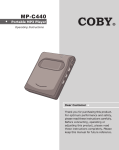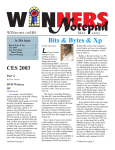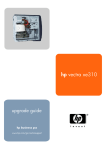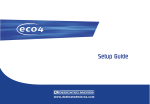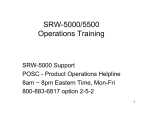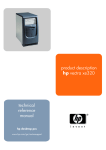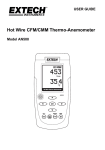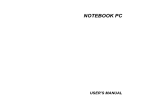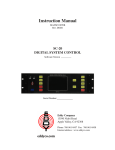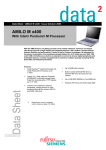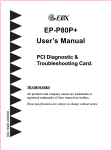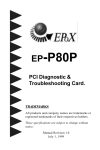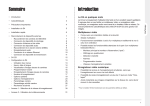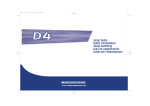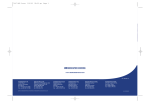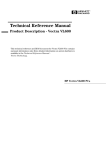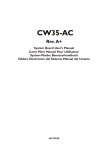Download HP e-pc 810E User's Manual
Transcript
technical reference manual product description - hp e-pc This technical reference and BIOS document for the HP e-pc contains summary information only. More detailed information on system hardware is available in the Technical Reference Manual - HP PC Technology. HP e-pc Contents 1 system overview hp e-pc components and technical features. . . . . . . . . . . . . . . . . . . . . 2 package features . . . . . . . . . . . . . . . . . . . . . . . . . . . . . . . . . . . . . . . . . . . 3 specifications . . . . . . . . . . . . . . . . . . . . . . . . . . . . . . . . . . . . . . . . . . . . . . 5 2 system features hp e-pc system board layout . . . . . . . . . . . . . . . . . . . . . . . . . . . . . . . . 10 architectural view . . . . . . . . . . . . . . . . . . . . . . . . . . . . . . . . . . . . . . . . . 12 main memory . . . . . . . . . . . . . . . . . . . . . . . . . . . . . . . . . . . . . . . . . . . . . 13 processors . . . . . . . . . . . . . . . . . . . . . . . . . . . . . . . . . . . . . . . . . . . . . . . 13 CMOS/password switch . . . . . . . . . . . . . . . . . . . . . . . . . . . . . . . . . . . . 14 mass storage devices. . . . . . . . . . . . . . . . . . . . . . . . . . . . . . . . . . . . . . . 15 graphic interface . . . . . . . . . . . . . . . . . . . . . . . . . . . . . . . . . . . . . . . . . . 18 audio . . . . . . . . . . . . . . . . . . . . . . . . . . . . . . . . . . . . . . . . . . . . . . . . . . . . 22 network interface . . . . . . . . . . . . . . . . . . . . . . . . . . . . . . . . . . . . . . . . . 23 3 serviceability swapping parts . . . . . . . . . . . . . . . . . . . . . . . . . . . . . . . . . . . . . . . . . . . . 26 Francais iii 4 BIOS overview BIOS summary . . . . . . . . . . . . . . . . . . . . . . . . . . . . . . . . . . . . . . . . . . . 30 power saving and ergonometry . . . . . . . . . . . . . . . . . . . . . . . . . . . . . 33 BIOS addresses. . . . . . . . . . . . . . . . . . . . . . . . . . . . . . . . . . . . . . . . . . . 34 order in which the POST tests are performed . . . . . . . . . . . . . . . . . 38 beep codes and error messages . . . . . . . . . . . . . . . . . . . . . . . . . . . . . 44 5 drivers and software drivers . . . . . . . . . . . . . . . . . . . . . . . . . . . . . . . . . . . . . . . . . . . . . . . . . . 46 software . . . . . . . . . . . . . . . . . . . . . . . . . . . . . . . . . . . . . . . . . . . . . . . . . 46 BIOS updates . . . . . . . . . . . . . . . . . . . . . . . . . . . . . . . . . . . . . . . . . . . . 47 iv Francais 1 system overview This chapter introduces the internal and external features, and lists the specifications of the HP e-pc. 1 system overview hp e-pc components and technical features hp e-pc components and technical features Component Package Description Processor HP e-pc No Free access shelves Width: 8.9cm (3.5 in); Height: 24.0 cm (9.4 in); Depth: 27.2 cm (10.7 in). Intel Celeron 500/66, 533/66, 633/66, 700/66 Intel Pentium III 600EB/133, 667/133, 800/133, 866/133 System Board: Chip set Intel® 810E Integrated I/O On ICH chip. 2 USB connectors, 1 serial port and 1 parallel port, 2 PS/2 (keyboard, mouse), 1 15-pin VGA connector, audio ports (stereo-in, stereo-out, microphone in) Integrated IDE On ICH chip. 2 IDE Ports (Ultra ATA 66) Integrated Graphics Intel® 810E integrated graphics with Direct AGP and Dynamic Video Memory Technology. Integrated Audio CS4299: CrystalClear™ Sound Fusion Audio Codec ‘97 Integrated network interface 3COM 10/100 Mbps 3C905C-TX Network Interface (RJ-45 Ethernet port (10/100Base-T) Mass storage Main memory Input devices Power supply BIOS Hard disks: 8.4GB IDE, 10GB IDE, 20GB IDE CD-ROM drive: 24X Max-speed slim CD-ROM (in selected models) DVD drive: 8x Max-speed (in selected models) CD-RW drive: Available as accessory C4505A USB Floppy drive: Available as accessory D9510A One SDRAM socket using: 64MB, 128MB, 256MB HP Standard Keyboard HP Scrolling Mouse External 60W Power Supply Type: AmiBIOS Version: IN.xx.yy Setup program: English only BIOS error messages: English only 2 1 system overview package features package features Power on Status Light (flashes in sleep mode) Front view Hard Disk Drive Activity Light Power On/ Off Button Hard Disk Drive compartment CD-ROM Drive (some models only) Fan Front view with cover removed Processor located below fan Main Memory located behind RFI filler plate. CD-ROM, DVD or CD-RW drive 3 1 system overview package features rear connectors Parallel Port USB Keyboard LAN Connector Power Connector Monitor Serial Ports Line In Mouse Microphone 4 Speaker 1 system overview specifications specifications physical characteristics Characteristic Description Weight (excluding display and keyboard) 3.5 kg (7.7 pounds) Dimensions Width: 8.9cm (3.5 inches) Height: 24.0cm (9.4 inches) Depth: 27.2 cm (10.7 inches) Footprint Vertical Position1: 0.021 m2 (0.23 ft.2) Horizontal Position: 0.065 m2 (0.69 ft.2) Power Adapter Input voltage: 100-240 Vac (auto-range) Input frequency: 50/60 Hz Output Voltage: 19V Maximum output power: 60W (max) Power Consumption (components) Nominal: 30W Windows 98 Suspend: 15W 1. Dimensions do not include the stand 5 1 system overview specifications both platforms power consumption As an ENERGY STAR partner, HP has determined that this product meets the ENERGY STAR guidelines for energy efficiency (standard base models). Power Consumption (PC running Windows98) Operating with input/output: 38W Operating without input/output: 21W Suspend: 15W Automatic Sleep Mode: 4.1W Off: 2.2W These are “typical” values given for the standard base models. NOTE When the PC is turned off with the power button on the front panel, the power consumption falls below 5 Watts, but is not zero. The special on/off method used by this PC extends the lifetime of the power supply. To reach zero power consumption in “off” mode, unplug the AC adapter from the power outlet or unplug the AC adapter from the HP e-pc. If the PC is turned off, the time settings are maintained by the battery indefinitely (until the battery runs out of power). acoustic noise emission Acoustic Noise Emission (ISO 7779) Sound Power (Average) Sound Power (ISO 9296) Sound Pressure (ISO 9296) Operating (idle) LwA =32.4 dBA LwAd = 33 dBA LpA = 24 dBA Operating with disk access LwA = 39.1 dBA LwAd = 42 dBA LpA = 34 dBA Operating with CD-ROM access LwA = 44.7 dBA LwAd = 48 dBA LpA = 37 dBA The values are given for the standard configuration as shipped and can vary depending on the actual components used. 6 1 system overview specifications environmental specifications Environmental Specifications (System Processing Unit, with Hard Disk) Operating Temperature 5oC - 35oC Storage Temperature -40oC to 70oC Operating Humidity 15% to 80% (relative) Storage Humidity 8% to 85% (relative), non-condensing at 40°C (104°F) Acoustic Noise Emission: (as defined ISO 7779) Sound level (LwA) ≤ 37 db (operating) Operating Altitude 10000 ft (3100m) max Storage Altitude 15000ft (4600m) max Operating temperature and humidity ranges may vary depending upon the mass storage devices installed. High humidity levels can cause improper operation of disk drives. Low humidity levels can aggravate static electricity problems and cause excessive wear of the disk surface. 7 1 system overview specifications 8 2 system features This chapter describes core components of the HP e-pc such as processors, chip set, mass storage devices, graphics controller, audio controller, network features and input devices. 2 system features hp e-pc system board layout hp e-pc system board layout All HP e-pc system boards have a Celeron/Pentium III processor slot. system board 2 stacked USB connectors Line OUT Line Mic IN IN Power Connector Keyboard mouse LAN LAN The parallel port is located above Serial Port and VGA connector IDE connector Audio HDD Power Connector CMOS/Password Switch CD-ROM connector Battery Socket Processor Socket 810E chipset with embedded graphics Status panel connector Memory slot Power Fan connector 10 2 system features hp e-pc system board layout hp e-pc PCI mapping HP e-pc PCI Mapping Table Bus Device PCI Device 0 0 MCH chip 0 1 VGA 0 30 ICH chip: PCI bridge 0 31 ICH chip 0 31 Integrated audio (CoDec) 1 2 Integrated LAN 11 2 system features architectural view architectural view Processor Celeron or Pentium III Display System Memory System Bus (66/133MHz) GMCH Intel 82810e 64bit (66/100MHz) 266 MB/s LAN PCI 33 HDD and CDD ICH Intel 82801AA CS4299 LPC Bus AUDIO AC97 USB FWH INTEL 82802AB(4M) 12 ATA33/66 Super I/O PS/2 KB and MS Serial and // 2 system features main memory main memory There is one 168-pin DIMM slot on the system board for installing main memory. All HP e-pc models are supplied with a memory module of at least 64 MB non-ECC SDRAM. Only HP memory modules are supported. Memory upgrades are not supported. processors The HP e-pc is equipped with either a single Socket 370 Intel Celeron or socket 370 Intel Pentium III processor. Socket 370 is a conversion of Slot 1 (used previously by Celerons and Pentium Is) to a socket, running at the same bus protocol as the Pentium II (the GTL+ bus protocol). The processor is connected to the system board through a Plastic Pin Grid Array (PPGA) 370 Socket. The reduction in size achieved by the Socket 370 Celeron is due to the integration of the L2 cache on the processor die. Like the Celeron processor, the Pentium III comes in a 370-pin socket (PGA370) package. To find out more about Socket 370 Celeron technology, refer to the Technical Reference Manual - HP PC Technology. 13 2 system features CMOS/password switch CMOS/password switch The position of the CMOS/password switch is shown below: SWITCH BLOCK Switch CMOS/ Password 14 Switch function: OFF = normal (default) ON = clear CMOS and reload default values in Setup, clear Passwords 2 system features mass storage devices mass storage devices hard disk drives A 3.5-inch hard disk drive is supplied. This hard drive is provided with the HP e-pc and comes with a hard disk drive tray attached. To see which other hard disk drives can be purchased as accessories for the HP e-pc, refer to www.hp.com/go/pcaccessories. 8.4GB Ultra-ATA 66 10 GB Ultra-ATA 100 20 GB Ultra-ATA 100 Average Seek Times (ms) 12 8.9 <9 I/O data-transfer rate (Mbytes/Sec max) 66 66 66 ATA data-transfer modes supported PIO modes 0-4 Multiword DMA modes 0-2 Ultra DMA modes 3-4 Internal Data Rate (Mb/s) 248 330 330 Buffer Size Ultra ATA 512 KM 2 MB 2 MB To find out about Ultra-ATA DMA 33/66 hard disk drive technology, refer to the Technical Reference Manual - HP PC Technology. 15 2 system features mass storage devices CD-ROM (CD/CD-ROM, CD-R, CD-RW) and DVD drives Models may be fitted with a 24✕ Max Slim IDE CD-ROM drive or 8 x Max Slim IDE DVD-ROM drive. These can play standard CD-ROM discs, conforming to optical and mechanical standards as specified in the Red and Yellow Book. To find out about CD-ROM and DVD drive technology, refer to Technical Reference Manual - HP PC Technology. features of the slim CD-ROM drive • • • • • CD-DA CD-ROM Mode1,Mode 2 CD-I (Mode 2 Form 1 and 2) Photo-CD (single and multisession) Enhanced CD Description HP product number Host Interface IDE (ATAPI) Disc Diameter 120 mm Storage Capacity 656 Mbytes Data Transfer Rate Burst: 33.3 MBs (max) Sustained: 1545 ~3600KBs Features of the slim DVD-ROM Drive Average Access Time 115msec (average) Buffer Memory 128 Kbytes Rotational speed 5136rpm • • • • • • • • • • • • CD-DA as defined by Red Book CD-ROM data in Mode 1 and Mode 2 as defined by Yellow book CD-ROM XA data Form 1 and Form 2 CD-I, CD-I Bridge and CD-I Ready Single and Multiple Session discs CD-RW Video CD Photo CD Enhanced Music CD DVD Disc DVD-R Disc DVD-RAM Disc 16 2 system features mass storage devices Description HP product number Disc Diameter Disk Capacity Data Transfer Rate Random Access Time Full Stroke 1.Constant NOTE 120 mm CD-ROM: 656MB (mode 1), 748MB (mode 2) DVD-ROM: 4.7 GBytes (Single Layer), 8.5 GBytes (Dual Layer) Sustained CD-ROM: Max 3.6 MBytes/sec DVD-ROM: Max 5.4 MBytes/sec 24 MAX CAV1 1550 ~3600 Kbytes/sec (Mode1) 1768 ~4106 Kbytes (Mode2) 170 ms (typical) 270 ms (average max.) 320 ms (typical) 480 ms (average max.) Angular velocity If a disk is still in the drive after power failure or drive failure, the disk can be reclaimed by inserting a straightened paper-clip into the small hole at the bottom of the door. 17 2 system features graphic interface DVD region codes The DVD software is only able to play DVD video discs from regions 1 and 2 (see table below). DVD region settings can be changed up to 5 times. Region Codes Region Supported by the DVD software 1 USA & Canada Yes 2 Europe & Japan Yes 3 South East Asia No 4 Latin America & Australia No 5 Russia, Rest of Asia, Africa No 6 China No graphic interface The HP e-pc uses Intel® 810E integrated graphics with Direct AGP and Dynamic Video Memory technology. The video memory is dynamically allocated on system memory (SDRAM) by the chip set, and shared with main memory. Depending on the configuration and application, between 4 and 10MB of main memory may be reserved for video. Its architecture consists of dedicated multi-media engines executing in parallel to deliver high performance 3D, 2D and motion compensation video capabilities. The 3D and 2D engines are managed by a 3D/2D pipeline preprocessor allowing a sustained flow of graphics data to be rendered and displayed. 18 2 system features graphic interface specifications • Integrated Graphics Controller ❒ 3D Hyper Pipelined Architecture ❒ Full 2D H/W Acceleration ❒ Motion Video Acceleration • 3D Graphics Visual Enhancements ❒ Flat & Gouraud Shading ❒ Mip Maps with Bilinear and Anisotropic Filtering ❒ Fogging Atmospheric Effects ❒ Z Buffering ❒ 3D Pipe 2D Clipping ❒ Backface Culling • 3D Graphics Texturing Enhancements ❒ Per Pixel Perspective Correction Texture Mapping ❒ Texture Compositing ❒ Texture Color Keying/Chroma Keying • Display ❒ Integrated 24-bit 230 MHz RAMDAC ❒ Gamma Corrected Video ❒ DDC2B Compliant 19 2 system features graphic interface 2D Graphics • ❒ Up to 1600x1200 in 8-bit Color at 75 Hz Refresh ❒ Hardware Accelerated Functions ❒ 3 Operand Raster BitBLTs ❒ 64x64x3 Color Transparent Cursor Arithmetic Stretch Blitter Video • ❒ H/W Motion Compensation Assistance for S/W MPEG2 Decode ❒ Software DVD at 30 fps ❒ H/W Overlay Engine with Bilinear Filtering ❒ Independent gamma correction, saturation, brightness & contrast for overlay Integrated Graphics Memory Controller • ❒ Intel®. D.V.M. Technology supported resolutions The following non-interlaced resolutions are supported for Windows 2000 and WIndows 98, with ergonomic refresh rates up to 1280 x 1024: 20 Resolution 256 colors (8-bit) 64K colors (16-bit) 16.7M colors (24-bit) 640 × 480 800 × 600 1024 × 768 60–85Hz 60–85Hz 60–85Hz 60–85Hz 60–85Hz 60–85Hz 60–85Hz 60–85Hz 60–85Hz 1152 × 864 1 1280 × 1024 1600 × 1200 60–85Hz 60–85Hz 60–75Hz 60–85Hz 60–85Hz 60–85Hz 60–85Hz 2 system features graphic interface connectors A 15-pin VGA DB connector is located on the rear panel of the HP e-pc (refer to the system board diagram on page 10 for its location). 15-pin VGA DB Connector 21 2 system features audio audio CS4299: CrystalClear Sound Fusion Audio Codec ‘97 The CS4299 is an AC’97 2.1 compatible stereo audio codec designed for PC multimedia systems. Using the industry leading CrystalClear delta-sigma and mixed signal. High fidelity audio is achieved through features such as differential CD audio input, which cancels out PC activity noise. In addition, the system’s converters are a highly efficient over-sampling scheme to perform up to 20-bit analog-to-digital and digital-analog conversion. Through its use of DirectX, this crystal audio solution offers high-end audio features such as 3-D localization, surround, room effects and Doppler effect: • AC ‘97 2.1 Compatible • Industry Leading Mixed Signal Technology • 20-bit Stereo Digital-to-Analog converter and 18-bit Stereo Analog to Digital Converter with a sample rate conversion. • Analog line-level stereo inputs for connection from LINE IN and CD • Analog microphone mono input (electret type) • High quality pseudo-differential CD input • Stereo line-level output • Extensive power management support • Meets or exceeds Microsoft PC 98 and PC 99 audio performance requirements • CrystalClear 3D stereo enhancement • Sample rate converters All models have a Line In jack, Line Out jack and Mic In jack connector located on the rear panel. These external jacks are standard connectors. speaker Microphone 22 Line In 2 system features network interface network interface All HP e-pcs feature an integrated 10/100 3Com network interface equivalent to the 3C905C-TX network interface card. This network solution is a 32-bit PCI Ethernet Controller with advanced manageability capabilities. It features full-duplex, automatic 10/100 BT port selection, Remote Wake-Up (RWU), and, depending on OS support, Remote Power-On (RPO). NOTE A 3COM LAN Boot ROM is integrated in the BIOS ROM chip on the system board. specifications Network Interface I/O Base Address: The NIC address can be selected using diagnostic software provided with the driver Transmit/Receive Buffer Memory Labels Manageability Power Management Pre-OS boot protocol support Ethernet IEEE 802.3 industry standard 10 Mbps baseband CSMA/CD (10BASE-T) and 100 Mbps baseband CSMA/CD (100Tx, FX) standards, 10 Mbps baseband CSMA/CD (10BASE2 and 10BASE5). Any 32-bit I/O base address NIC occupies 32 bytes of I/O space 4 KB. 2 KB transmit, 2 KB receive Microsoft PC97, Microsoft PC98, Microsoft PC99, Net PC, PCI 2.2 DMI 2.0 and 2.0s ACPI 1.0 PXE, BootP/DHCP, NCP, RPL network interface advanced features The 3Com chip supports First Plug Remote Power On. This means that once the HP e-pc is set up and connected, if a Magic Packet is sent from a server, the HP e-pc powers on. TCP/IP Ping Wake-up is supported under Windows 98 and Windows 2000 in ACPI mode. 23 2 system features network interface network interface diagnostics (not installed by default) The 3Com Network Interface driver also includes an in-depth diagnostics program. It enables the user to test the LAN chip, the network Interface layers, and the communication between machines. connectors The 10/100BT connector is located on the rear of the HP e-pc. LAN Connector For more information on network technology, refer to the Technical Reference Manual - HP PC Technology. 24 3 serviceability This chapter introduces the enhanced serviceability features of the HP e-pc. 3 serviceability swapping parts swapping parts The HP e-pc has 5 modules: • • • • • mouse keyboard external power supply HP e-pc unit hard disk drive and tray These modules have been designed for easy replacement. returning your HP e-pc for repair The hard disk drive has been designed to be easily removed. In the event of system failure, HP Support may advise you to remove your hard disk and return the system for repair or replacement 1 Switch off the monitor and HP e-pc. Unplug the AC adapter from the wall socket. 2 Using the key, unlock the port control system (if installed) and hard drive compartment cover at the rear of the HP e-pc. Remove the port control system. 26 3 serviceability swapping parts 3 Disconnect the power cord and any telecommunication cables. 4 Slide back and then lift off the compartment cover. 5 Lift the rear of the hard drive tray clear of the HP e-pc using the handle. This is to gain access to the data and power connectors. 6 Remove the data and power connectors. 7 Using the handle, lift the hard drive tray out of the HP e-pc. The hard disk drive should never be removed from it’s tray. 27 3 serviceability swapping parts 28 4 BIOS overview This chapter describes the BIOS features of HP e-pc models. 4 BIOS overview BIOS summary BIOS summary The HP e-pc contain an HP/AMI BIOS. The system ROM contains the POST (power-on self-test) routines, and the BIOS: the System BIOS, video BIOS, and 3Com LAN option ROM. The system BIOS is identified by the version number IN.xx.yy. The latest BIOS version for your HP e-pc and instructions for updating the BIOS can be downloaded from the HP’s Support Web site at: www.hp.com/go/e-pcsupport This section covers: • • • • • The BIOS Setup program Power saving BIOS addresses The order in which POST tests are performed Beep codes using the HP setup program Press F2 to run the Setup program, when the “HP” logo is displayed immediately after restarting the HP e-pc. Press F8 to enter the Boot menu. Use the boot menu to select the order of the devices the HP e-pc will use to start (boot) from. Press F12 to boot on LAN. This overrides the Boot Policy selected from the HP Setup Screen. Alternatively, press Esc to view the summary configuration screen. The summary configuration screen will remain on the screen until a key is pressed. A summary screen will also be displayed at the end of POST. The Setup screen has only one menu. auto-detection and auto-configuration Auto-detection and auto-configuration are essential to the ease of use concept. The HP BIOS avoids users having to enter Setup by automating many of the selection procedures: • Conflict detection and resolution of system board, PCI, and PnP devices and their resources. • Auto-configuration and optimization of chip set based on bus speeds 30 4 BIOS overview BIOS summary • IDE HDD auto-detection, including support for IDE drives > 8.4GB • ATAPI CD-ROM auto-detection • PS/2 Mouse and Keyboard detection NOTE A USB floppy is installed as a standard drive by the BIOS (drive A: or E:). A USB floppy is installed as drive A: (for Windows 2000) or drive E: (Windows 98), depending on the number of external drives attached. HP setup screen The Setup page contains the following fields: • • • • • • • • • • • • • System Time System Date Boot Policy F12 Hot Key to Boot on LAN CD-ROM Set Supervisor Password Set User Password Integrated Audio Interface Integrated USB Interface Serial Port Parallel Port Mode Processor Serial Number1 The menu items contained in this page are largely security features. The purpose of this page is to facilitate the prevention of Unauthorized users from using or booting from selected drives and network connections for example: • Boot Policy: Allows you to select the devices and the order of the devices from which the BIOS attempts to boot the operating system. During POST, if the BIOS is unsuccessful at booting from one device, it will then try the next one on the list until an operating system is found. • F12 Hot Key to Boot On LAN: Allows the user to enable or disable this feature. • CD-ROM, Integrated Audio Interface, Integrated USB Interface, Serial Port and Parallel Port: These menu items enable you to unlock/lock these integrated Data Communications Ports • Supervisor Password. This password prevents unauthorized access to the 1. This menu item is hidden when the Celeron processor is detected. 31 4 BIOS overview BIOS summary computer’s configuration. It can also be used to start the computer. • User Password. This password can only be set when a supervisor password has been set. The User Password prevents unauthorized use of the computer, protects stored data. 32 4 BIOS overview power saving and ergonometry power saving and ergonometry soft power down Soft Power Down is available with the Windows NT operating system. If users want to shut down their HP e-pc, they are able to do so directly from the Windows NT interface. There is no longer any need to physically switch off the HP e-pc. The hardware to do this is contained in the ICH chipset. This chipset is described in detail in Technical Reference Manual - HP PC Technology. safe off Safe Off is available with Windows NT4.0 operating systems. If users attempt to shut down the operating system when an application is open and has not been saved, they are requested to save their work before the computer can be powered off. NOTE Safe Off is integrated in Windows 98 and Windows 2000. The hardware to do this is contained in the ICH chipset. This chipset is described in detail in Technical Reference Manual - HP PC Technology. 33 4 BIOS overview BIOS addresses BIOS addresses This section provides a summary of the main features of the HP system BIOS. This is software that provides an interface between the computer hardware and the operating system. system memory map 0000 0000 - 0000 03FF Real-mode IDT 0000 0400 - 0000 04FF BIOS Data Area 0000 0500 - 0009 FC00 Used by OS 0009 FC00 - 0009 FFFF Extended BIOS Data Area 000A_0000 - 000B_FFFF Video RAM or SMRAM (not visible unless in SMM) 000C 0000 - 000C 7FFF Video ROM 000C 8000 - 000F FFFF Adapter ROM, RAM, memory-mapped registers 000E 0000 - 000F FFFF System BIOS (Flash/Shadow) 10 0000 - FF FFFF Memory (1 MB to 16 MB) 100 0000 - 1FF FFFF Memory (16 MB to 32 MB) 200 0000 -3FF FFFF Memory (32 MB to 64 MB) 400 0000 -1FFF FFFF Memory (64 MB to 512 MB) FFF80000 - FFFF FFFF 512 KB BIOS (Flash) hp I/O port map (I/O addresses used by the system) Peripheral devices, accessory devices and system controllers are accessed via the system I/O space, which is not located in system memory space. The 64 KB of addressable I/O space comprises 8-bit and 16-bit registers (called I/O ports) located in the various system components. 34 4 BIOS overview BIOS addresses Although the Setup program can be used to change some of the settings, the following address map is not completely BIOS dependent, but is determined partly by the operating system. Note that some of the I/O addresses are allocated dynamically. I/O Address Ports 0000 - 000F 0010-001F, 0022 -003F, 0044-005F, 0062-0063, 0065-006F, 0072-007F, 0084-0086, 04D0-04D1, 0080, 0088, 008C-008E, 0090-009F, 00A2-00BF, 00E0-00EF, 0400-047F, 0480-04BF, 04D0-04D1, 0800-0847F 0020 - 0021, 00A0-00A1 0040 - 0043 0060, 0064 0061 0070 - 0071 0081 - 0083, 008F, 0087, 0089-008B, 00C0-00DF 00F0 - 00FF 0170 - 0177 01F0 - 01F7 0376 0378 - 037F, 0778 - 077F 03F8 - 03FF 0CF8 - 0CFF 03B0-03BB, 03C0-03DF 0540-054F B000-BFFF BC00-BC7F 03F6, FFA0 - FFA7, FFA0-FFAF D400-D41F D800-D83F, DCFF FFA0-FFA7 FFA0-FFAF FFA8-FFAF Function DMA controller Motherboard resources Programmable Interupt Controller System Timer PC/AT Enhanced Keyboard System Speaker RTC and CMOS data DMA Controller Numeric Data Processor Ultra ATA Controller, Secondary ATA Controller Ultra ATA Controller, Primary ATA Controller Ultra ATA Controller, Secondary ATA Controller LPT1 ECP COM1 PCI bus Chipset Graphic Drivers SMBus controller PCI Bridge NIC Ultra ATA Controller, Primary ATA Controller USB Universal Host Controller Audio Primary ATA Controller Ultra ATA Controller Secondary ATA Controller 35 4 BIOS overview BIOS addresses DMA channel controllers Only “I/O-to-memory” and “memory-to-I/O” transfers are allowed. “I/O-to-I/O” and “memory-to-memory” transfers are disallowed by the hardware configuration. The system controller supports seven DMA channels, each with a page register used to extend the addressing range of the channel to 16 MB. The following table summarizes how the DMA channels are allocated. DMA controller Channel Function 0 Free 1 Free if not used for parallel port in Setup 2 Free 3 Free if not used for parallel port in Setup 4 Used to cascade DMA channels 0-3 5 Free 6 Free 7 Free interrupt controllers The Interrupt Requests (IRQ) are numbered sequentially, starting with the master controller, and followed by the slave. IRQ (Interrupt Vector) Interrupt Request Description INTR IRQ0 System Timer IRQ1 Keyboard Controller IRQ3 3 COM LAN IRQ4 Used by serial post if enabled - CON1 IRQ5 Audio AC’97 36 4 BIOS overview BIOS addresses IRQ (Interrupt Vector) Interrupt Request Description IRQ6 Free IRQ7 LPT1 IRQ8 RTC IRQ9 On board USB Controller IRQ10 VGA IRQ11 SCI ACPI IRQ12 Mouse IRQ13 Co-processor IRQ14 IDE Primary channel IRQ15 IDE Secondary channel. Free unless disabled 37 4 BIOS overview order in which the POST tests are performed order in which the POST tests are performed Each time the system is powered on, or a reset is performed, the POST is executed. The POST process verifies the basic functionality of the system components and initializes certain system parameters. The POST starts by displaying a graphic screen of the Hewlett-Packard logo when the HP e-pc is started. Devices, such as memory and newly installed hard disk drives, are configured automatically. The user is not requested to confirm the change. Newly removed hard disks are detected, and the user is prompted to confirm the new configuration by pressing F4. Note, though, that the POST does not detect when a hard disk drive has been otherwise changed. During the POST, the BIOS and other ROM data is copied into high-speed shadow RAM. The shadow RAM is addressed at the same physical location as the original ROM in a manner which is completely transparent to applications. It therefore appears to behave as very fast ROM. This technique provides faster access to the system BIOS firmware. The following table lists the POST checkpoint codes written at the start of each test. uncompressed INIT code checkpoints 01 NMI is Disabled. CPU ID saved.Init code Checksum verification starting. 02 To do DMA init, Keyboard controller BAT test, start memory refresh and going to 4GB flat mode. D3 To start Memory sizing. D4 To comeback to real mode. Execute OEM patch. Set stack. D5 E000 ROM enabled. Init code is copied to segment 0 and control to be transfered to segment 0. D6 Control is in segment 0. To check <CTRL><HOME> key and verify main BIOS checksum. If either <CTRL><HOME> is pressed or main BIOS checksum is bad, go to check point E0 else goto check point D7. D7 To pass control to Interface Module. 08 Main BIOS runtime code is to be decompressed. 09 Control to be passed to main BIOS in shadow RAM. 38 4 BIOS overview order in which the POST tests are performed boot block recovery code check points E0 OnBoard Floppy Controller (if any) is initialzed. To start base 512K memory test. E1 To initialise interrupt vector table. E2 To initialise DMA and interrupt controllers. E6 To enable floppy and timer IRQ, enable internal cache. ED Initialize floppy drive. EE Start looking for a diskette in drive A: and read 1st sector of the diskette. EF Floppy read error. F0 Start searching 'AMIBOOT.ROM' file in root directory. F1 'AMIBOOT.ROM' file not present in root directory. F2 Start reading FAT table and analyze FAT to find the clusters occupied by 'AMIBOOT.ROM' file.. F3 Start reading 'AMIBOOT.ROM' file cluster by cluster. F4 'AMIBOOT.ROM' file not of proper size. F5 Disable internal cache. FB Detect Flash type present. FC Erase Flash. FD Program Flash. FF Flash program successful. BIOS is going to restart. runtime code is uncompressed in F000 shadow ram 03 NMI is Disabled. To check soft reset/power-on. 05 BIOS stack set. Going to disable Cache if any. 06 POST code to be uncompressed. 07 CPU init and CPU data area init to be done. 08 CMOS checksum calculation to be done next. 0B Any initialization before keyboard BAT to be done next. 0C KB controller I/B free. To issue the BAT command to keyboard controller. 0E Any initialization after KB controller BAT to be done next. 0F Keyboard command byte to be written. 10 Going to issue Pin-23,24 blocking/unblocking command. 39 4 BIOS overview order in which the POST tests are performed 11 Going to check pressing of <INS> , <END> key during power-on. 12 To init CMOS if "Init CMOS in every boot" is set or <END> key is pressed. Going to disable DMA and Interrupt controllers. 13 Video display is disabled and port-B is initialized. Chipset init about to begin. 14 8254 timer test about to start. 19 About to start memory refresh test. 1A Memory Refresh line is toggling. Going to check 15us ON/OFF time. 23 To read 8042 input port and disable Megakey GreenPC feature. Make BIOS code segment writeable. 24 To do any setup before Int vector init. 25 Interrupt vector initialization about to begin. To clear password if necessary. 27 Any initialization before setting video mode to be done. 28 Going for monochrome mode and color mode setting. 2A Different BUSes init (system, static, output devices) to start if present. (Please see Appendix for details of different BUSes). 2B To give control for any setup required before optional video ROM check. 2C To look for optional video ROM and give control. 2D To give control to do any processing after video ROM returns control. 2E If EGA/VGA not found then do display memory R/W test. 2F EGA/VGA not found. Display memory R/W test about to begin. 30 Display memory R/W test passed. About to look for the retrace checking. 31 Display memory R/W test or retrace checking failed. To do alternate Display memory R/W test. 32 Alternate Display memory R/W test passed. To look for the alternate display retrace checking. 34 Video display checking over. Display mode to be set next. 37 Display mode set. Going to display the power on message. 38 Different BUSes init (input, IPL, general devices) to start if present. (Please see Appendix for details of different BUSes). 39 Display different BUSes initialization error messages. (Please see Appendix for details of different BUSes). 3A New cursor position read and saved. To display the Hit <DEL> message. 40 To prepare the descriptor tables. 42 To enter in virtual mode for memory test. 40 4 BIOS overview order in which the POST tests are performed 43 To enable interrupts for diagnostics mode. 44 To initialize data to check memory wrap around at 0:0. 45 Data initialized. Going to check for memory wrap around at 0:0 and finding the total system memory size. 46 Memory wrap around test done. Memory size calculation over. About to go for writing patterns to test memory. 47 Pattern to be tested written in extended memory. Going to write patterns in base 640k memory. 48 Patterns written in base memory. Going to findout amount of memory below 1M memory. 49 Amount of memory below 1M found and verified. Going to findout amount of memory above 1M memory. 4B Amount of memory above 1M found and verified. Check for soft reset and going to clear memory below 1M for soft reset. (If power on, go to check point# 4Eh). 4C Memory below 1M cleared.(SOFT RESET) Going to clear memory above 1M. 4D Memory above 1M cleared.(SOFT RESET) Going to save the memory size. (Goto check point# 52h). 4E Memory test started.(NOT SOFT RESET) About to display the first 64k memory size. 4F Memory size display started. This will be updated during memory test. Going for sequential and random memory test. 50 Memory testing/initialization below 1M complete. Going to adjust displayed memory size for relocation/ shadow. 51 Memory size display adjusted due to relocation/ shadow. Memory test above 1M to follow. 52 Memory testing/initialization above 1M complete. Going to save memory size information. 53 Memory size information is saved. CPU registers are saved. Going to enter in real mode. 54 Shutdown successful, CPU in real mode. Going to disable gate A20 line and disable parity/NMI. 57 A20 address line, parity/NMI disable successful. Going to adjust memory size depending on relocation/shadow. 58 Memory size adjusted for relocation/shadow. Going to clear Hit <DEL> message. Going to clear Hit <DEL> message. 59 Hit <DEL> message cleared. <WAIT...> message displayed. About to start DMA and interrupt controller test. 60 DMA page register test passed. To do DMA#1 base register test. 62 DMA#1 base register test passed. To do DMA#2 base register test. 65 DMA#2 base register test passed. To program DMA unit 1 and 2. 66 DMA unit 1 and 2 programming over. To initialize 8259 interrupt controller. 7F Extended NMI sources enabling is in progress. 41 4 BIOS overview order in which the POST tests are performed 80 Keyboard test started. clearing output buffer, checking for stuck key, to issue keyboard reset command. 81 Keyboard reset error/stuck key found. To issue keyboard controller interface test command. 82 Keyboard controller interface test over. To write command byte and init circular buffer. 83 Command byte written, Global data init done. To check for lock-key. 84 Lock-key checking over. To check for memory size mismatch with CMOS. 85 Memory size check done. To display soft error and check for password or bypass setup. 86 Password checked. About to do programming before setup. 87 Programming before setup complete. To uncompress SETUP code and execute CMOS setup. 88 Returned from CMOS setup program and screen is cleared. About to do programming after setup. 89 Programming after setup complete. Going to display power on screen message. 8B First screen message displayed. <WAIT...> message displayed. PS/2 Mouse check and extended BIOS data area allocation to be done. 8C Setup options programming after CMOS setup about to start. 8D Going for hard disk controller reset. 8F Hard disk controller reset done. Floppy setup to be done next. 91 Floppy setup complete. Hard disk setup to be done next. 95 Init of different BUSes optional ROMs from C800 to start. (Please see Appendix-I for details of different BUSes). 96 Going to do any init before C800 optional ROM control. 97 Any init before C800 optional ROM control is over. Optional ROM check and control will be done next. 98 Optional ROM control is done. About to give control to do any required processing after optional ROM returns control and enable external cache. 99 Any initialization required after optional ROM test over. Going to setup timer data area and printer base address. 9A Return after setting timer and printer base address. Going to set the RS-232 base address. 9B Returned after RS-232 base address. Going to do any initialization before Coprocessor test. 9C Required initialization before Coprocessor is over. Going to initialize the Coprocessor next. 9D Coprocesor initialized. Going to do any initialization after Coprocessor test. 9E Initialization after Coprocessor test is complete. Going to check extd keyboard, keyboard ID and num-lock. Keyboard ID command to be A2 Going to display any soft errors. 42 4 BIOS overview order in which the POST tests are performed A3 Soft error display complete. Going to set keyboard typematic rate. A4 Keyboard typematic rate set. To program memory wait states. A5 Going to enable parity/NMI. A7 NMI and parity enabled. Going to do any initialization required before giving control to optional ROM at E000. A8 Initialization before E000 ROM control over. E000 ROM to get control next. A9 Returned from E000 ROM control. Going to do any initialization requiredafter E000 optional ROM control. AA Initialization after E000 optional ROM control is over. Going to display the system configuration. AB To build MP table if needed. AC To uncompress DMI data and execute DMI POST init. B0 System configuration is displayed. B1 Going to copy any code to specific area. 00 Copying of code to specific area done. Going to give control to INT-19 boot loader. 43 4 BIOS overview beep codes and error messages beep codes and error messages If a terminal error occurs during POST, the system issues a beep code before attempting to display the error in the upper left corner of the screen. Beep codes are useful for identifying the error when the system is unable to display the error message. Number of Beeps 44 Error Message Description 1 Refresh Failure The memory refresh circuitry on the motherboard is faulty. 2 Parity Error Parity error in the first 64 KB of memory. 3 Base 64KB Memory Failure Memory failure in first 64 KB. 4 Timer Not Operational Memory failure in the first 64 KB of memory, or Timer 1 on the M/B is not functioning. 5 Processor error The CPU(Central Processing unit) on the M/B generated an error. 6 Processor Exception Interrupt Error The CPU generated an exception interrupt. 7 Processor Exception Interrupt Error The CPU generated an exception interrupt. 8 Display Memory Read/ Write Error The system video adapter is either missing or its memory is faulty. This is not a fatal error. 9 ROM Checksum Error The ROM checksum value does not match the value encoded in the BIOS. 10 CMOS Shutdown Register Read/ Write Error The shutdown register for CMOS RAM failed 11 Cache Error/ External Cache Bad The external cache is faulty 5 drivers and software This chapter provides information on the drivers and software preloaded with the HP e-pc. 5 drivers and software drivers drivers You can download up-to-date versions of drivers required for the HP e-pc from the “Software and Drivers” section of HP’s Support web site at www.hp.com/go/e-pcsupport. software HP e-pc models come preloaded with the following software. You can download the most up-to-date versions from the “Software and Drivers” section of HP’s Support web site at www.hp.com/go/e-pcsupport. operating systems• Windows 98 SE or Windows 2000 (note that you can install Windows NT 4.0 instead of Windows 2000 on some models) software• e-DiagTools • Norton AntiVirus 2000 (s10 small business models only) • Online documentation • SoftOff • TopTools • UDF Reader • Adobe Acrobat • Microsoft Word 2000 (some models) • Microsoft Office 2000 SB (some models) • Microsoft Works 2000 (some models) • Information Center (only on s10 small business models and in some countries) • e-pc c10 help (c10 corporate models only) 46 5 drivers and software BIOS updates BIOS updates The system BIOS is identified by the version number IN.xx.yy. The latest BIOS version for your PC and instructions for updating the BIOS can be downloaded from the HP support Web site at: www.hp.com/go/e-pcsupport. 47 5 drivers and software BIOS updates 48 about this document This technical reference and BIOS document for the HP e-pc contains summary information only. More detailed information on system hardware is available in the Technical Reference Manual - HP PC Technology. hp e-pc bibliography ❒ HP Information CD-ROM (see HP e-pc User’s Guide for ordering information) ❒ Technical Reference Manual -HP PC Technology www.hp.com/go/e-pcsupport ❒ HP e-pc Service Handbook Chapter at: www.hp.com/go/e-pcsupport. ❒ HP Support Assistant CD-ROM (by subscription). Data sheets can be obtained at: ❒ Pentium Processors www.intel.com/design/pentiumIII/datashts ❒ Product Data Sheet www.hp.com/e-pc xlix l The Technical Reference Manual contains the following documents available on the HP Information CD-ROM or downloadable from the Web in PDF format: • Introduction & HP e-pc Overview Describes how to use the Technical Reference Manual and provides a brief overview of the HP e-pc. • Product Description The document you are reading. Provides detailed BIOS information and summary information on the hardware components in the HP e-pc. • HP PC Technology A detailed look at the hardware components in the HP e-pc and selected HP Vectra PCs. Includes information on processors, chip set, graphics controller, network interface, connectors and sockets.
























































